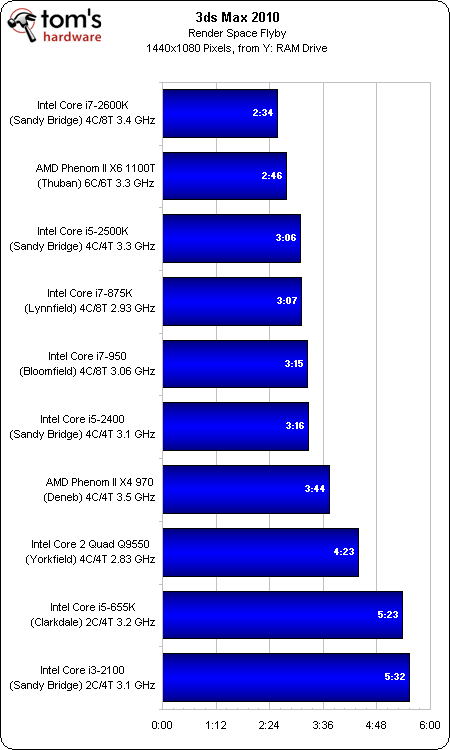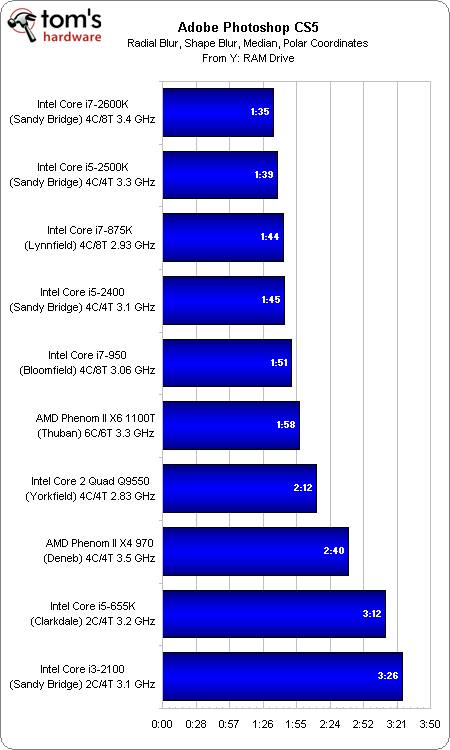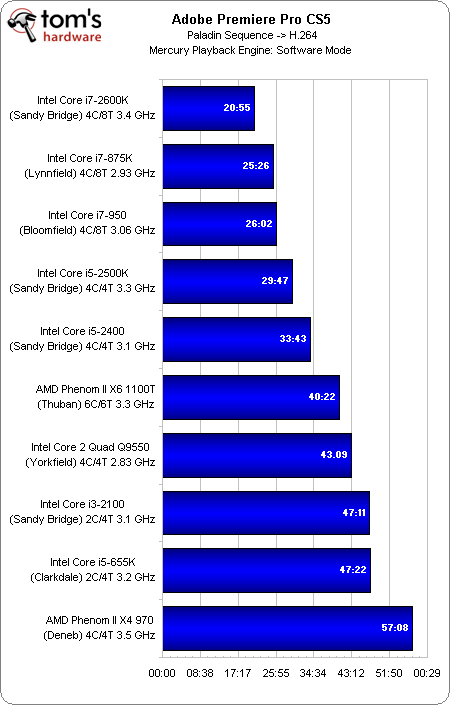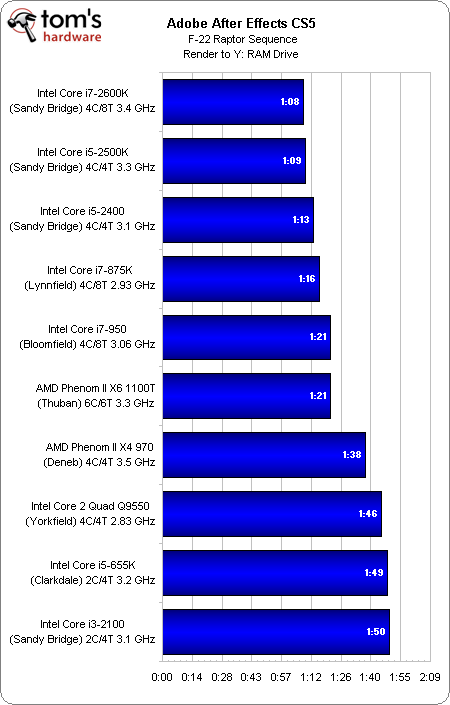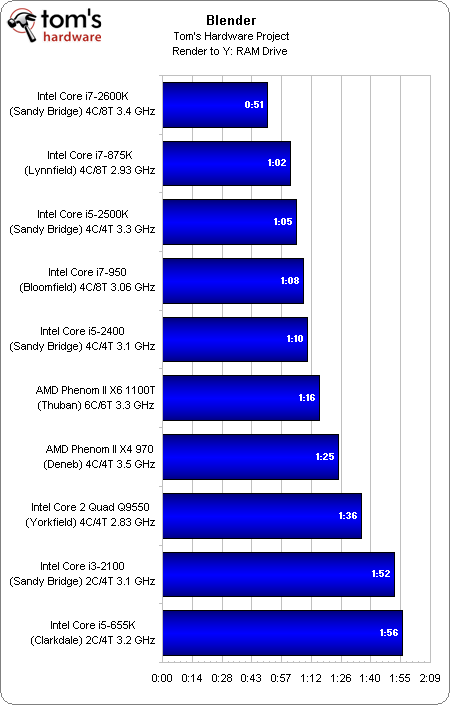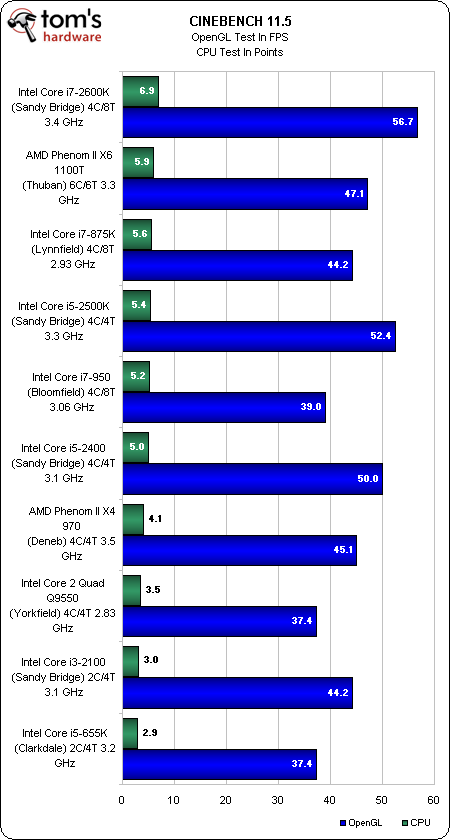Intel’s Second-Gen Core CPUs: The Sandy Bridge Review
Although the processing cores in Intel’s Sandy Bridge architecture are decidedly similar to Nehalem, the integration of on-die graphics and a ring bus improves performance for mainstream users. Intel’s Quick Sync is this design’s secret weapon, though.
Benchmark Results: Content Creation
When it comes to professional content creation, it’s more common to find apps optimized for as many processing cores as you make available. Given AMD’s Phenom II X6 1100T placement, 3ds Max 2010 is employing all six of that chip’s execution cores. But Intel still manages to swipe a first-place finish using its Core i7-2600K. That’s a roughly $320 Intel processor going up against a roughly $270 AMD chip. Overall, not a bad showing for AMD…
…that is, until you get to Intel’s Core i5-2500K, which follows right behind AMD’s flagship, offering an unlocked multiplier and 95 W TDP for just under $220. Note that it’s beating Intel’s Core i7-875K—a Hyper-Threading-enabled CPU that sells for $100 more at the time of publication.
The rest of the field falls in place behind, for the most part tightly grouped. Check out the Core i5-2400 and Core i7-950 going head-to-head. That’s a $184 CPU matching stride with a $300 chip.
Seemingly bottlenecked by something other than threading, Photoshop is almost as kind to the Core i5-2500K as it is to the -2600K, both of which slide past the Core i7-875K.
Surprisingly, the Bloomfield-based Core i7-950 falls to the middle of the pack, just ahead of AMD’s hexa-core flagship. Confused as to why that part is able to best the 3.5 GHz Phenom II X4 970? Either Turbo CORE is kicking in, allowing the X6 1100T to jump to 3.7 GHz, or Photoshop really can put all six cores to work.
At least we know it’s able to use more than two cores—both dual-core Intel parts bring up the rear, including the Core i3-2100 in last place.
We use this Paladin sequence for benchmarking graphics. However, Premiere Pro CS5 doesn’t officially support CUDA acceleration on the GeForce GTX 580 without a little software hack. Otherwise its Mercury Playback Engine leans on CPU muscle.
Get Tom's Hardware's best news and in-depth reviews, straight to your inbox.
More than 40 minutes of rendering time separates the first- and last-place finishers. We again see the Core i7-2600K up top—likely a result of heavy parallelism, which gives all three eight-thread CPUs first, second, and third spots. Two four-core Sandy Bridge chips follow, and AMD’s Phenom II X6 1100T falls behind them.
The message here is clear. First, if you’re doing heavy lifting in Premiere Pro, make sure you have CUDA support. We’ve seen this test finish in less than two minutes running on a mid-range GeForce card. Second, if you choose to ignore us on point one, throw as much CPU horsepower as possible at the app—it’ll use it.
Our custom After Effects benchmark isn’t as demanding as the Premiere Pro test. It’s hardly a surprise to see a trio of Sandy Bridge-based CPUs take the top three places, followed by Lynnfield and Bloomfield.
The six-core Phenom II X6 1100T’s extra processing resources give it an advantage over the Phenom II X4 970’s higher clock rate. And both AMD chips outmaneuver the older Core 2 Quad Q9550, along with Intel’s dual-core offerings.
By popular request, we’ve incorporated Blender into the test suite with a custom image rendering.
Starting from the bottom, both dual-core processors get embarrassed, despite the fact that Hyper-Threading allows each to operate on four threads at a time. Loud and clear, we’re hearing that dual-core chips aren’t the way to go for content creation.
Above that, you’re looking at a two-generation-old Core 2 Quad CPU and AMD’s fastest quad- and hexa-core processors. AMD’s placement on the charts is a little deceptive though, since the Phenom II X6 1100T is only six seconds slower than Intel’s Core i5-2400.
Still, the X6 1100T is priced at $265, while Intel asks $184 for its quad-core part.
Although the OpenGL test was run using a GeForce GTX 580 on all of these platforms, its results look like a shotgun blast on the wall. More relevant here are the CPU ratings, which put the Core i7-2600K in its familiar first-place spot, followed by AMD’s Phenom II X6 1100T.
Current page: Benchmark Results: Content Creation
Prev Page Benchmark Results: SiSoftware Sandra 2011 Next Page Benchmark Results: Productivity-
cangelini MoneyFace pEditor, page 10 has mistakes. Its LGA1155, not LGA1555.Reply
Fixed, thanks Money! -
juncture "an unlocked Sandy Bridge chip for $11 extra is actually pretty damn sexy."Reply
i think the author's saying he's a sexually active cyberphile -
fakie Contest is limited to residents of the USA (excluding Rhode Island) 18 years of age and older.Reply
Everytime there's a new contest, I see this line. =( -
englandr753 Great article guys. Glad to see you got your hands on those beauties. I look forward to you doing the same type of review with bulldozer. =DReply -
joytech22 Wow Intel owns when it came to converting video, beating out much faster dedicated solutions, which was strange but still awesome.Reply
I don't know how AMD's going to fare but i hope their new architecture will at least compete with these CPU's, because for a few years now AMD has been at least a generation worth of speed behind Intel.
Also Intel's IGP's are finally gaining some ground in the games department. -
cangelini fakieContest is limited to residents of the USA (excluding Rhode Island) 18 years of age and older.Everytime there's a new contest, I see this line. =(Reply
I really wish this weren't the case fakie--and I'm very sorry it is. We're unfortunately subject to the will of the finance folks and the government, who make it hard to give things away without significant tax ramifications. I know that's of little consolation, but that's the reason :(
Best,
Chris -
LuckyDucky7 "It’s the value-oriented buyers with processor budgets between $100 and $150 (where AMD offers some of its best deals) who get screwed."Reply
I believe that says it all. Sorry, Intel, your new architecture may be excellent, but unless the i3-2100 series outperforms anything AMD can offer at the same price range WHILE OVERCLOCKED, you will see none of my desktop dollars.
That is all.
